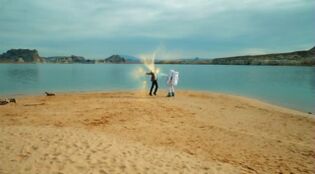Still point in time: Difference between revisions
From Tardis Wiki, the free Doctor Who reference
Meganerd18 (talk | contribs) No edit summary Tags: Reverted Visual edit |
No edit summary Tags: Manual revert 2017 source edit |
||
| Line 3: | Line 3: | ||
Instead, the Silence merely assumed the Doctor died at Lake Silencio without realising he could and would find a way to fake his death thanks to the time-travelling vehicle the ''[[Teselecta]], ''allowing him to survive. ([[TV]]: ''[[The Wedding of River Song (TV story)|The Wedding of River Song]]'') | Instead, the Silence merely assumed the Doctor died at Lake Silencio without realising he could and would find a way to fake his death thanks to the time-travelling vehicle the ''[[Teselecta]], ''allowing him to survive. ([[TV]]: ''[[The Wedding of River Song (TV story)|The Wedding of River Song]]'') | ||
[[Category:Temporal theory]] | [[Category:Temporal theory]] | ||
Revision as of 07:27, 16 August 2023

The Silence exploited the still point in time that was Lake Silencio to engineer the Doctor's death. (TV: The Wedding of River Song)
According to Dorium Maldovar, still points in time made it easier to create fixed points in time. The Kovarian Chapter of the Silence used one such point in space-time — 5:02 PM on 22 April 2011 by Lake Silencio — to make the Eleventh Doctor's supposed death there a fixed point.
Instead, the Silence merely assumed the Doctor died at Lake Silencio without realising he could and would find a way to fake his death thanks to the time-travelling vehicle the Teselecta, allowing him to survive. (TV: The Wedding of River Song)
